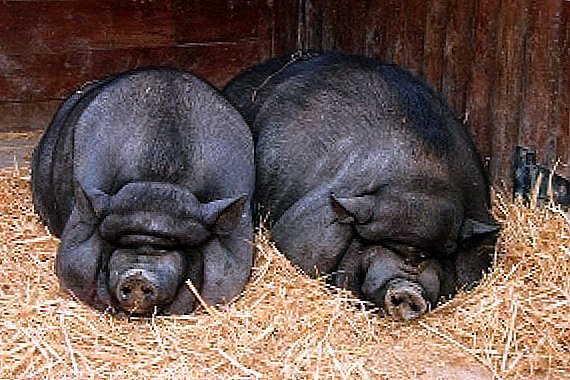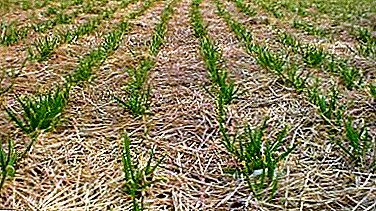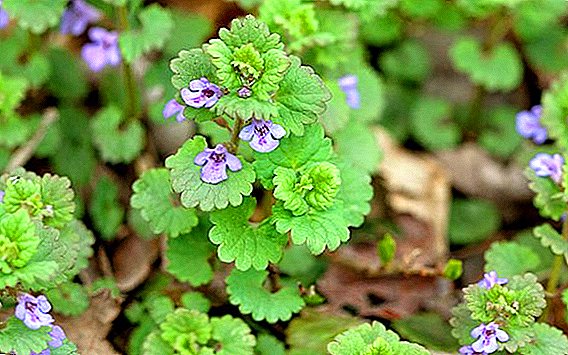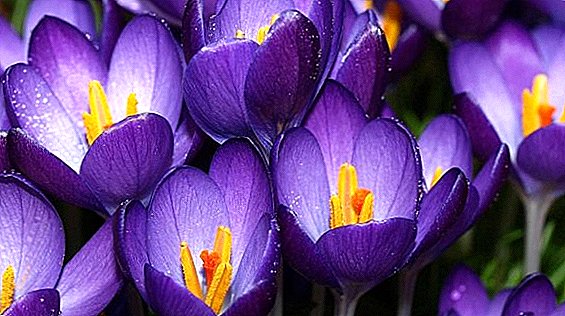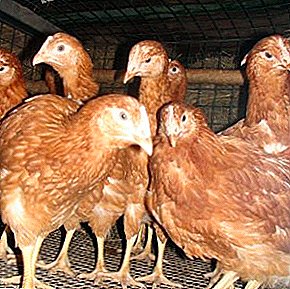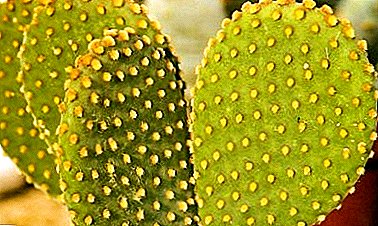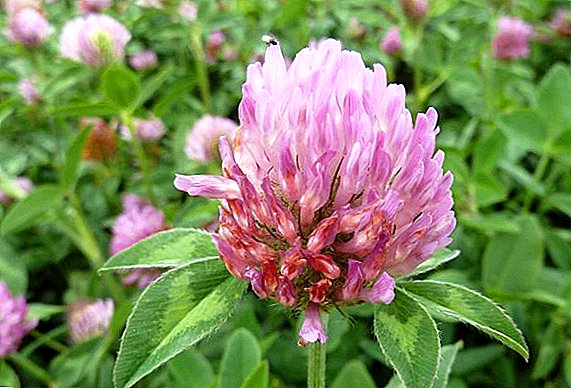 There are many varieties of clover. But for medical purposes and in the recipes of traditional medicine, red clover is usually used, on its basis some medical and homeopathic preparations are produced.
There are many varieties of clover. But for medical purposes and in the recipes of traditional medicine, red clover is usually used, on its basis some medical and homeopathic preparations are produced.
Features of the use and cultivation of plants will consider in the article.
Botanical description
This plant is more commonly known as meadow clover, and its botanical name in Latin is Trifolium pratеnse. It belongs to the genus of clover of the moth family of the legume family. This is usually a perennial grass (sometimes two years old), growing to a height of 15-55 centimeters.
Blossoms from June to September red-pink loose tubular flowers, collected in the head, having the shape of a ball. Inflorescences are sometimes in pairs and have a heterogeneous or whitish color. The stems of this plant branch, they grow leaves-shamrocks.
The fruits ripen in August and October and look like a small oval bean with one seed. These seeds can be used for plant reproduction. Clover can also grow vegetatively. 
Did you know? Red clover is an excellent forage crop with a high level of nutritional value. It is used for harvesting hay and silage for livestock. In addition, it can accumulate nitrogen on the roots and be used as siderat.
Spread
The red clover is widely distributed in Eurasia and in the north of Africa. It grows in meadows, glades, with roads. Grown as a fodder plant.
Chemical composition
Clover contains these vitamins:
- C, ascorbic acid;
- B1, thiamine;
- B2, riboflavin;
- E, tocopherol;
- carotene.
Learn more about the types of clover, the benefits of how white clover is used.
 The following substances are known to contain in the grassy mass of this plant:
The following substances are known to contain in the grassy mass of this plant:- essential oils;
- tannins;
- glycosides;
- resins;
- fixed oils;
- amino acids;
- organic acids;
- coumarin;
- phytoestrogens;
- flavonoids (including quercetin, maakaiin).
Phytoestrogens are found in grape seed, hop, black cohosh, Chinese magnolia vine, linden, marjoram, and black currant.

Healing properties of red clover
This rich composition gives red clover a number of healing properties:
- anti-inflammatory;
- antimicrobial;
- antifungal;
- immunostimulating;
- rejuvenating;
- tonic;
- antioxidant;
- anti-cancer;
- antisclerotic;
- diaphoretic;
- diuretic;
- expectorant.
As a diuretic, use juniper, pumpkin, turmeric, avran, red onion, dill, butcher, fennel, lingonberry leaves, agave.
Use in traditional medicine
Due to the presence of natural phytohormones, the use of this plant for women and men has a positive effect on their health and well-being.
For women
On the female body receiving this herb affects as follows:
- increases libido;
- facilitates the flow of menopause;
- serves to prevent the onset of osteoporosis in women due to menopause;
- helps with painful periods, with inflammatory diseases of the female organs;
- is the prevention of cancer of the breast and female organs;
- promotes the production of collagen, which allows to improve the appearance of the skin and smooth out wrinkles.
Did you know? Red clover is a part of some homeopathic remedies, such as feminal and femwell.
For men
It is also useful for men to use red clover because it:
- increases libido, potency;
- helps with erection problems;
- carries out prostate cancer prevention;
- cleans blood vessels from cholesterol, which is most often elevated in men.

Indications for use
This plant is used in the treatment of the following list of diseases:
- cardiovascular diseases (atherosclerosis, high cholesterol, hypertension, and others);
- colds and flu (also for their prevention);
- bronchitis and pneumonia;
- skin diseases, including rash in children;
- wounds and burns;
- cystitis;
- physical exhaustion after illness or stress;
- rheumatism;
- diarrhea and intestinal disorders;
- inflammation of the ovaries and other inflammatory processes in the female organs;
- diseases of the liver and gallbladder.
In cystitis use cranberries, calendula, sedge, lilac, parsley, aspen, Ivan-tea, euphorbia, parsnip, pine resin.
Harm and side effect
This bioactive plant should not be consumed continuously. Its long-term use due to the presence of phytohormones can disrupt the natural cycle or lead to impotence. It is best to apply a course of treatment.
Clover should not be consumed before planned operations and for some time after them, since this plant thins blood and can cause bleeding. 
Important! If you are taking blood thinning medications, you should not use tea with clover at the same time.
Contraindications
Red clover should not be consumed when:
- pregnancy;
- hormone-dependent tumors of any etiology;
- poor blood clotting;
- individual intolerance (is rare);
- thrombophlebitis.
Infusion for external use
For external use, make a strong infusion using the following ingredients:
- three tablespoons of the crushed raw materials;
- 250 ml of water.
 The resulting infusion is washed with diathesis skin and other rashes, psoriasis. Lotions of gauze or cotton are applied to wounds and burns, boils, abscesses. They can also wash out inflamed eyes, gargle a sore throat or oral cavity. This infusion is suitable for douching in inflammatory processes in the vagina, belyah.
The resulting infusion is washed with diathesis skin and other rashes, psoriasis. Lotions of gauze or cotton are applied to wounds and burns, boils, abscesses. They can also wash out inflamed eyes, gargle a sore throat or oral cavity. This infusion is suitable for douching in inflammatory processes in the vagina, belyah.After cooling down, the product is placed in a refrigerator: it can be stored there for no more than two days.
Infusion for internal use
Infusion for internal use is made from the following ingredients:
- three tablespoons of vegetable raw materials;
- 1.5 glasses of pure water.
This infusion will be useful for migraines, tinnitus, atherosclerosis, increased pressure, insomnia, as well as for colds, coughs, bronchitis and pneumonia. It can be drunk with anemia, exhaustion, male and female problems, including menopause.
When menopause should pay attention to the yarrow, loon pueraria, Veronica, nasturtium, primrose, hawthorn, blue cyanosis, peppermint, lavender, sweet potato.This infusion can be stored in the refrigerator for up to two days, but it will be better to prepare it daily.

Tincture on vodka
For the preparation of therapeutic tinctures use the following ingredients:
- one glass of fresh clover heads;
- 0.5 liters of vodka (alcohol).
This tincture is effective for high cholesterol and atherosclerosis.
To lower cholesterol, it is taken once a day, 20 minutes before meals. To do this, dilute 15 ml of tincture in 50 ml of pure water. Such treatment should last no more than three months.
When atherosclerosis should eat garlic, rowan red, currant leaves, Jerusalem artichoke, beets, carrots, rape honey.In case of atherosclerosis, in order to clear the vessels, this tincture is drunk once a day before going to bed at a dose of 20 ml. Drink two weeks, then take a ten-day break and repeat the two-week course.
How to make tea
The simplest and most pleasant taste of this medicinal plant is the use of tea.
For its preparation you will need:
- one teaspoon of dried clover heads;
- 250 ml of pure water.
One glass of such a healing drink at night will help you fall asleep for insomnia.
In this drink, you can add a little honey. Each time you should prepare a new tea, because it is most tasty and fragrant fresh.
Did you know? Red clover flowers can be added to green tea and tea blends. Fresh leaves are put in salads, like other greens. They can also be added to green borscht, sauces.
Growing clover
In some areas, this meadow plant grows on its own, but you can grow it yourself. After all, red clover is a good sider, it perfectly enriches the soil with nitrogen, restores it, helps to get rid of weeds. This beautiful, besides medicinal, plant will not only improve the soil, but also give the site a decorative look.
Choice of location and lighting
The meadow clover is cold-resistant enough, but it does not tolerate severe frosts below -7 ° C. He also does not like high temperatures - the summer heat for him is destructive. The first year of life, he tolerates frost to -17 ° C, but in the second and third year - not below -12 ° C. The optimum temperature regime for the growth of meadow clover is in the range from + 17 ° C to + 20 ° C.
This plant likes good lighting, but it tolerates shade normally. For him, cereal crops, potatoes and other root vegetables are good precursors.
Soil preparation and fertilizers
Red clover loves moisture, but its excess can destroy it. This plant likes humus moderately moist, without the presence of stagnant water, soil with low acidity. Loamy soils with low acidity are also well suited to it. Does not like sand, sour soil containing a lot of salt.
Before sowing, it is recommended to dig the soil about 30 cm and thoroughly clean the area from weeds that will interfere with the growth of this crop. To speed up the process, you can use the cultivator.
It will not be superfluous to add phosphorus-potassium fertilizers to increase the yield. For this purpose, not only mineral fertilizers, but also Optim-Humus organic fertilizers, as well as preparations of effective soil microorganisms (for example, EM-preparations) are perfect. In the future, the fertilizing of clover is carried out in the fall and spring.
Mustard, rye, oats, phacelia, alfalfa, buckwheat, rape, sweet clover are grown as siderat.
Sowing and reproduction
Clover seeds before planting, it is desirable to process using rhizotorphine or nitragin. This process contributes to a more rapid emergence and reproduction of nodule bacteria, which in turn has a positive effect on the growth of this plant.  Red clover is sown in the prepared soil in early spring, when frost will pass.
Red clover is sown in the prepared soil in early spring, when frost will pass.
His seeds are quite small, so they need to be sown to a depth of 1-2 cm. The sowing rate is 170 grams per one hundred square meters, but with manual and late sowing, this standard is increased by one and a half times.
Watering and moisture
This plant prefers moisture, but does not tolerate stale water. In summer, the clover does not like strong heat and needs periodic watering.
Diseases and pests
Red clover is prone to diseases such as anthracnose, cancer, rust, ascochitis. To reduce the risk of these diseases, it is necessary to give preference to disease-resistant varieties, as well as to treat the seeds before sowing, to mow the grass at the beginning of flowering. To combat such diseases, special dusting with sulfur powder and fungicides is used.
Pests for this plant are weevils that infect flowers - one larva destroys about 10 ovaries. To control these pests, clover should also be mowed before flowering or insecticides should be used.
Harvesting and storage of raw materials
Red clover is harvested during its flowering, from June to September. Collect the heads-inflorescences together with the top leaves, which are usually intergrown with a flower.
Important! You can not collect vegetable raw materials along roads and in places with unfavorable environmental situation.You can dry the plant in special electric dryers in green mode, or you can simply spread it out on paper, avoiding the rays of the sun. The layer of inflorescences should be single, should be avoided pile. It is also necessary to ensure that the harvested plants are not dry, as this loses some of the useful properties. Dried raw materials are stored year in paper or linen bags, in closed cardboard boxes in a dark dry place.
Red clover will help to cope with many health problems. But the reception of this plant containing phytohormones, should not be long, as it can be harmful. This healing herb can be used as a pleasant enough to taste tea, which will be useful for colds, insomnia and menopause. It can be sown at the dacha not only as a medicinal plant, but also as a siderat.



